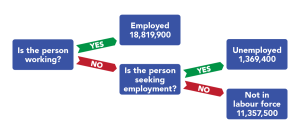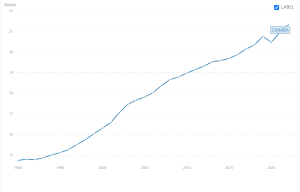5.1 The Labour Force
Should we count everyone without a job as unemployed? Of course not. For example, we should not count children as unemployed. Surely, we should not count the retired as unemployed. Many full-time college students have only a part-time job or no job at all, but it seems inappropriate to count them as suffering the pains of unemployment. Some people are not working because they are rearing children, ill, on vacation, or on parental leave.

The point is that we do not just divide the adult population into employed and unemployed. The adult population is called the working-age population. Anyone aged 15 and over is included in the working-age population, as defined by Statistics Canada (2022). Apart from the people employed or unemployed within the working age group, a third group exists: people who do not have a job, and for some reason—retirement, looking after children, taking a voluntary break before a new job—are not interested in having a job. It also includes those who want a job but have quit looking, often due to discouragement due to their inability to find suitable employment. Economists refer to this third group of those who are not working and not looking for work as out of the labour force or not in the labour force.
The Canadian unemployment rate, which is based on a monthly labour force survey carried out by Statistics Canada, asks a series of questions to divide the adult population into employed, unemployed, or not in the labour force. To be classified as unemployed, a person must be without a job, currently available to work, and actively looking for work in the previous four weeks. Thus, a person who does not have a job but who is not currently available to work or has not actively looked for work in the last four weeks is counted as out of the labour force.
Therefore,
- Employed: currently working for pay
- Unemployed: out of work and actively looking for a job
- Out of the labour force: out of paid work and not actively looking for a job
- Labour force: the number of employed plus the unemployed

Fig 5.1 above shows how the unemployment rate is computed. A monthly survey of households divides the civilian adult population into three groups. Those who have jobs are counted as employed; those who do not have jobs but are looking for them and are available for work are counted as unemployed; and those who are not working and are not looking for work are not counted as members of the labour force. The unemployment rate equals the number of people looking for work divided by the sum of the number of people looking for work and the number of people employed. Values are for February 2012, and all numbers are in thousands:
[latex]\begin{align*}\text{Unemployment Rate}&=\frac{\text{Looking For Work}}{\text{Looking For Work} + \text{Employed}}\\[2ex]&=\frac{1,369,400}{18,819,900+ 1,369,400}\\[2ex]&=0.083\\[2ex]&=6.7\%\end{align*}[/latex]
The unemployment rate in January 2022 was 6.7%.
Interactive Tool: Canada Labour Force
Attribution
"5.3 Unemployment" from Principles of Macroeconomics by University of Minnesota is licensed under a Creative Commons Attribution-NonCommercial-ShareAlike 4.0 International License, except where otherwise noted.
"8.1 How Economists Define and Compute Unemployment Rate" from Principles of Macroeconomics 3e by OpenStax-Rice University is licensed under a Creative Commons Attribution 2.0 license except where otherwise noted.


